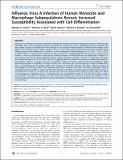Files in this item
Influenza virus A infection of human monocyte and macrophage subpopulations reveals increased susceptibility associated with cell differentiation
Item metadata
| dc.contributor.author | Hoeve, Marieke A. | |
| dc.contributor.author | Nash, Anthony A. | |
| dc.contributor.author | Jackson, David | |
| dc.contributor.author | Randall, Richard E. | |
| dc.contributor.author | Dransfield, Ian | |
| dc.date.accessioned | 2013-11-05T10:31:09Z | |
| dc.date.available | 2013-11-05T10:31:09Z | |
| dc.date.issued | 2012-01-04 | |
| dc.identifier | 19524348 | |
| dc.identifier | db8a96ef-24fd-43b4-9f41-86a285471be8 | |
| dc.identifier | 000301070200028 | |
| dc.identifier | 84855388904 | |
| dc.identifier.citation | Hoeve , M A , Nash , A A , Jackson , D , Randall , R E & Dransfield , I 2012 , ' Influenza virus A infection of human monocyte and macrophage subpopulations reveals increased susceptibility associated with cell differentiation ' , PLoS ONE , vol. 7 , no. 1 , e29443 . https://doi.org/10.1371/journal.pone.0029443 | en |
| dc.identifier.issn | 1932-6203 | |
| dc.identifier.other | ORCID: /0000-0002-9304-6678/work/60426974 | |
| dc.identifier.uri | https://hdl.handle.net/10023/4155 | |
| dc.description.abstract | Influenza virus infection accounts for significant morbidity and mortality world-wide. Interactions of the virus with host cells, particularly those of the macrophage lineage, are thought to contribute to various pathological changes associated with poor patient outcome. Development of new strategies to treat disease therefore requires a detailed understanding of the impact of virus infection upon cellular responses. Here we report that human blood-derived monocytes could be readily infected with the H3N2 influenza virus A/Udorn/72 (Udorn), irrespective of their phenotype (CD14(++)/CD16(-), CD14(++)/CD16(+) or CD14(dim)CD16(++)), as determined by multi-colour flow cytometry for viral haemagglutinin (HA) expression and cell surface markers 8-16 hours post infection. Monocytes are relatively resistant to influenza-induced cell death early in infection, as approximately 20% of cells showed influenza-induced caspase-dependent apoptosis. Infection of monocytes with Udorn also induced the release of IL-6, IL-8, TNF alpha and IP-10, suggesting that NS1 protein of Udorn does not (effectively) inhibit this host defence response in human monocytes. Comparative analysis of human monocyte-derived macrophages (Mph) demonstrated greater susceptibility to human influenza virus than monocytes, with the majority of both pro-inflammatory Mph1 and anti-inflammatory/regulatory Mph2 cells expressing viral HA after infection with Udorn. Influenza infection of macrophages also induced cytokine and chemokine production. However, both Mph1 and Mph2 phenotypes released comparable amounts of TNF alpha, IL-12p40 and IP-10 after infection with H3N2, in marked contrast to differential responses to LPS-stimulation. In addition, we found that influenza virus infection augmented the capacity of poorly phagocytic Mph1 cells to phagocytose apoptotic cells by a mechanism that was independent of either IL-10 or the Mer receptor tyrosine kinase/Protein S pathway. In summary, our data reveal that influenza virus infection of human macrophages causes functional alterations that may impact on the process of resolution of inflammation, with implications for viral clearance and lung pathology. | |
| dc.format.extent | 14 | |
| dc.format.extent | 873499 | |
| dc.language.iso | eng | |
| dc.relation.ispartof | PLoS ONE | en |
| dc.subject | Influenza virus | en |
| dc.subject | Macrophage | en |
| dc.subject | Monocyte | en |
| dc.subject | Cellular response | en |
| dc.subject | Lung pathology | en |
| dc.subject | Q Science | en |
| dc.subject | SDG 3 - Good Health and Well-being | en |
| dc.subject.lcc | Q | en |
| dc.title | Influenza virus A infection of human monocyte and macrophage subpopulations reveals increased susceptibility associated with cell differentiation | en |
| dc.type | Journal article | en |
| dc.contributor.institution | University of St Andrews. School of Biology | en |
| dc.contributor.institution | University of St Andrews. Biomedical Sciences Research Complex | en |
| dc.identifier.doi | https://doi.org/10.1371/journal.pone.0029443 | |
| dc.description.status | Peer reviewed | en |
This item appears in the following Collection(s)
Items in the St Andrews Research Repository are protected by copyright, with all rights reserved, unless otherwise indicated.

